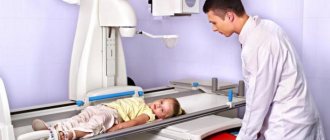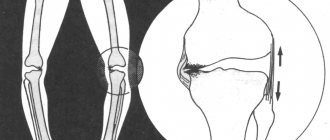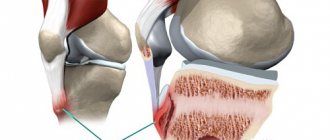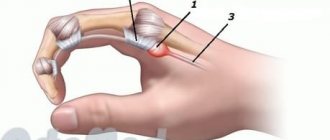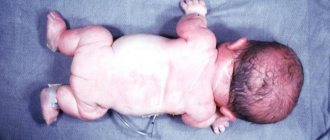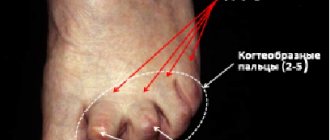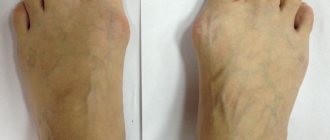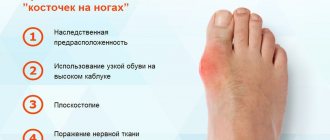- Causes
- Symptoms
- Conservative treatment
- Surgery
- Video
- Photo
- Main
An O-shaped or varus curvature of the legs is characterized by a pathological change in the knee joints, in which compression of the internal meniscus occurs and the joint space expands from the outside of the joint. Such changes lead to stretching of the ligaments that hold the knee joint in place. If varus deformity of the legs is not treated, then the femur can turn outward and the lower leg inward, and the person will become disabled . Since the knee in this type of pathology does not fully straighten, and when it bends (due to the increased load on the joints) a sharp pain is felt, the body strives to soften (compensate) these negative manifestations, as a result of which a person develops secondary flat feet, posture is disturbed, and osteochondrosis and the likelihood of developing arthrosis increases . If a child has such a curvature, then it should be corrected as quickly as possible in order to minimize the risk of falls and rapid physical fatigue due to improper gait.
Varus curvature of the legs: why pathology develops
There are not many reasons leading to varus curvature of the legs; among the main ones are childhood deformities caused by rickets, as well as injuries and previous diseases of bones and joints. It has been noticed that the curvature of the legs increases as a person grows older . For example, the curvature of the limbs often increases with diabetes. Children at risk (bone changes can occur during fetal development) as well as athletes, especially runners, boxers and gymnasts.
The main causes of varus curvature of the legs in children:
- hereditary factor;
- fetal hypoxia or prematurity;
- illnesses suffered by the mother during pregnancy;
- deficiency of calcium and vitamin D, A, B 12;
- rickets, bone pathology, metabolic disorders.
Among the common causes of curvature of the legs in adults are injuries to the bones, muscles and joints of the legs. A special case is bruises, sprains and other injuries to the limbs, in which a person does not experience severe pain , and therefore does not consult a doctor in the hope that everything will go away on its own. As a result, a crack or even a fracture of the bone remains unattended, and their improper fusion provokes curvature of the lower leg.
I would like to draw attention to the fact that deformation of the legs is often caused by rickets, and persistent late rickets is especially dangerous, developing against the background of chronic pathologies of the kidneys and intestines, and therefore cannot be treated with regular doses of vitamin D. Thus, steatorrhea (intestinal rickets) is a disease in which the absorption of calcium, phosphates, fats and vitamins is inhibited, almost always leading to varus deformity of the legs. But with renal rickets, valgus deformity often develops (the legs become like the letter X), as well as Blount's disease (angular curvature of the lower leg) and Paget's disease (affects the tibia and femur). Children usually suffer from bilateral varus curvature of the legs, while adults suffer from unilateral curvature (if the disease develops in adulthood after an injury).
What causes?
The foot of a child under 3–4 years old is very different from the foot of an adult. The structure of bones contains a lot of water and cartilage tissue, which is less durable than bone. Underdeveloped muscles and ligaments. Therefore, under the influence of negative internal and external factors, its proper development may be disrupted.
The formation of varus deformity of the feet in children usually occurs immediately after birth or in early childhood.
She is called:
- difficulties of intrauterine development (oligohydramnios, multiple pregnancies, abnormalities in the structure of the uterus, past infections and disorders of the fetal nervous system);
- endocrine pathologies;
- hereditary predisposition;
- injuries;
- chronic infectious and inflammatory diseases that weaken the body;
- vitamin D deficiency;
- impaired absorption of calcium;
- incorrectly selected shoes;
- early attempts to put the baby on his feet and early walking.
Varus is not always a pathology. It is often caused by muscle hypertonicity in infants, after which the position of the foot is normalized.
Symptoms of varus deformity of the leg
There are not many people who are satisfied with the shape of their own legs. According to statistics, every fifth woman is embarrassed by her legs, considering them far from ideal. The fact that the legs are crooked is visible to the naked eye, but there are also parameters that experts urge you to focus on. Thus, the correct shape of the leg involves three internal contours, reminiscent of a spindle, located in the upper part of the thigh, in the area of the knee and ankle . Another test to determine the ideal shape of the legs: a straight line drawn from the hip joint downwards with the correct shape of the legs should pass through the middle of the patella and between the big and adjacent toes.
Since, due to crooked shins, a person often develops flat feet, it can be painful for him to walk, and if a child is born with such a defect, he will not be able to fully move and will lag behind his peers in physical development . Even if visually the varus deformity of the legs is not very pronounced, the development of pathology is indicated by the habit of trampling shoes outward.
If you suspect a curvature of the lower leg, you should contact a traumatologist and orthopedist . In addition to X-rays of the legs, diagnostics include MRI (magnetic resonance imaging) and clinical blood and urine tests.
Conservative treatment of varus curvature of the legs in children and adults
In congenital pathologies and those caused by rickets, the curvature of the legs is clearly visible, but often the disease develops slowly and until a certain point the legs remain straight. However, the process is ongoing and attentive parents will definitely notice that the child wears the shoes unevenly, namely: the outer side of the sole and heel is larger than the inner side, and they will turn to an orthopedist. With varus deformity of the lower leg, when walking, the feet cannot make oscillatory movements due to the fact that almost the entire load falls on the outer part, so the foot loses its ability to soften (cushion) shocks and impacts that are natural for walking. As a result, the child loses stability, constantly falls, walks unsteadily and runs with great difficulty.
First of all, if you suspect varus curvature of the legs, you should take an x-ray of the lower extremities and check the condition of not only the legs, but also the hips and feet, as well as the hip and knee joints, in which unwanted compensatory changes may begin. It takes a long time to treat varus deformity of the legs . First, as a rule, conservative methods are used, for example, therapeutic exercises and massage, and if the disease progresses, then surgery is performed.
Physiotherapy. When a child has varus curvature of the leg, it is useful to do the following exercises:
- Stretching the medial (internal) ligament of the knee joint: with one hand, fix the lower part of the thigh from the outside, and with the other hand, perform springing movements outward of the lower third of the leg. Exercise improves the elasticity of tissues that are involved in the process of straightening the legs.
- Pressure on the articular surfaces of the knee: spread your legs wide and squat.
Of great benefit are walking barefoot, which loads the small muscles of the foot, as well as walking on two parallel boards located close to each other, the outer edges of which are raised (surfaces sloping inward).
Massage. After birth, the baby’s legs are bent for three months (the flexor position is preserved), so it is premature to talk about tibial varus until the baby begins to walk. Now is the time to show him to an orthopedic doctor , who, if necessary, will prescribe a massage of the back, abdomen and legs. The procedure uses the following techniques: stroking, kneading, rubbing and vibration to relax the inner surface of the thigh and lower leg.
Wearing orthopedic shoes. It is very important that the foot is fixed in the correct position, so patients suffering from varus deformity of the legs need to carefully select shoes and sandals, taking into account the recommendations of an orthopedic doctor.
Treatment
Natural progression of the disease
Physiological varus deformity of the knees almost always corrects itself as the child grows. This correction usually occurs between the ages of 3 and 4 years.
Untreated Blount's disease or untreated rickets leads to progressive worsening of the curve in later adolescence. These children end up with discomfort in their legs (especially the knees) due to excessive stress on the joints. Adolescents with Blount disease most often experience pain in the curve.
Non-surgical treatment method
Physiological genu varus: Although physiological genu varus does not require active treatment, your doctor should monitor your child every 6 months until the genu varus goes away.
Blount's disease. Early-onset Blount disease requires treatment to improve the curvature. If the disease is detected at an early stage, only treatment with a splint may be necessary. Leg bracing is not effective for adolescents with Blount disease.
Rickets. If your child has rickets, your doctor will refer you to a metabolic specialist for conservative treatment, in addition to regular orthopedic monitoring. Symptoms of rickets can often be controlled with medication.
Surgical method of treatment
Physiological varus deformity of the knees. In rare cases, the physiological varus deformity of the baby's knees does not completely resolve, and in adolescence, the varus deformity can cause the child and his family to worry about the appearance of the legs. If the deformity is severe enough, surgery may be required to correct the remaining curve.
Blount's disease. If a child with Blount's disease has progressive leg bowing, surgery will be necessary by age 4, despite the use of a splint. Surgery can stop the situation from getting worse and prevent permanent damage to the growth plate area.
Older children with bowed legs due to Blount disease require surgery to correct the problem.
Rickets. Surgery may also be necessary for children with rickets whose deformities persist despite proper medication treatment.
Surgical procedures. There are various procedures to correct o-shaped legs, and they fall into two main types.
Managed growth. This growth plate surgery stops growth on the healthy side of the leg, giving the deformed side a chance to catch up by straightening the leg with the baby's natural growth.
Osteotomy of the tibia. In this procedure, an incision is made in the lower leg just below the knee and reshaped to correct the curvature. The bone is held in position until it heals using an internal plate and screws, or an external fixator that is placed on the outside of the leg.
After surgery, a cast may be placed to protect the bone while it heals. Crutches may be necessary for several weeks, and your doctor may recommend physical therapy exercises to regain strength and range of motion. Your doctor will guide you through a full recovery period and return to normal activities.
Surgical treatment of varus curvature of the legs
If conservative treatment does not produce results, the patient undergoes a valgus osteotomy - a complex operation during which a wedge-shaped fragment is removed from the tibia, after which the bone sections are connected using screws. For osteosynthesis (bone fusion), the Elizarov apparatus is used. Its design takes into account the individual characteristics of the patient; wear the device from four to eight months.
During the surgical treatment of ankle deformity, there is a high risk of damage to blood vessels by knitting needles and rods pulled through the bone. Sometimes hematomas do not resolve on their own and, in order to avoid the development of an inflammatory process, they have to be opened and cleaned out. After surgery, some patients feel quite severe pain in the operated limb; in such cases, it is recommended to limit physical activity and use painkillers.
The main thing about varus curvature of the legs
| Question | Answer |
| Distinctive feature | the legs bend and take on the shape of the letter O. |
| Causes | in children: heredity, problems with intrauterine development, rickets, vitamin D deficiency; in adults: injuries of the lower extremities. |
| What to pay attention to | shoes wear down towards the outer edge of the foot, and flat feet develop. |
| How is varus curvature of the legs treated? | physical therapy, massage surgery (valgus osteotomy), wearing the Elizarov apparatus. |
| Which doctor should I contact? | to an orthopedist, surgeon, traumatologist. |
Symptoms, health risks and modern treatment options at NOAHKLINIK, Kassel
Varus is a medical term meaning an osteoarticular abnormality in which a person's legs are curved inward. With valgus - in the opposite direction, forming an X-shaped appearance of the legs. Varus and valgus deformities can affect different parts of the lower extremities. Today, such anomalies can be effectively treated in the clinic of aesthetic and reconstructive medicine of Professor Noah.
In the vast majority of cases, varus and valgus deformities of the limbs are congenital anomalies of the musculoskeletal system. Almost always, such deformities are observed in a child immediately from birth. Its birth signs may look different:
- the plantar part is located at an angle - inward and downward;
- the sole is turned inward, and the supporting area is the tarsus or part of the tarsus;
- adduction is a noticeable increase in the arch, in which it is also slightly directed inward.
In this article we will consider separately varus and valgus deformities, as well as possible treatment options for the disease available to modern medicine. And in particular those that are currently used in the clinic of Professor Ernst Noah.
